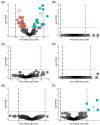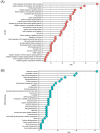Systemic circulating microRNA landscape in Lynch syndrome
- PMID: 36282188
- PMCID: PMC10092425
- DOI: 10.1002/ijc.34338
Systemic circulating microRNA landscape in Lynch syndrome
Erratum in
-
Correction to "Systemic circulating microRNA landscape in Lynch syndrome".Int J Cancer. 2024 Apr 1;154(7):E6-E8. doi: 10.1002/ijc.34828. Epub 2023 Dec 29. Int J Cancer. 2024. PMID: 38158590 Free PMC article. No abstract available.
Abstract
Circulating microRNAs (c-miRs) are small noncoding RNA molecules that migrate throughout the body and regulate gene expression. Global c-miR expression patterns (c-miRnomes) change with sporadic carcinogenesis and have predictive potential in early detection of cancers. However, there are no studies that have assessed whether c-miRnomes display similar potential in carriers of inherited pathogenic mismatch-repair gene variants (path_MMR), known as Lynch syndrome (LS), who are predisposed to highly increased cancer risk. Using high-throughput sequencing and bioinformatic approaches, we conducted an exploratory analysis to characterize systemic c-miRnomes of path_MMR carriers, sporadic rectal cancer patients and non-LS controls. We showed for the first time that cancer-free path_MMR carriers have a systemic c-miRnome of 40 differentially expressed c-miRs that can distinguish them from non-LS controls. The systemic c-miRnome of cancer-free path_MMR carriers also resembles the systemic c-miRnomes of cancer patients with or without path_MMR. Our pathway analysis linked the found differentially expressed c-miRs to carcinogenesis. A total of 508 putative target genes were identified for 32 out of 40 differentially expressed c-miRs, and 238 of them were enriched in cancer-related pathways. The most enriched c-miR-target genes include well-known oncogenes and tumor suppressor genes such as BCL2, AKT3, PIK3CA, KRAS, NRAS, CDKN1A and PIK3R1. Taken together, our findings suggest that LS and sporadic carcinogenesis share common biological pathways and alterations in these pathways can produce a c-miR signature which can track potential oncogenic stress in cancer-free path_MMR carriers. Therefore, c-miRs hold potential in monitoring the LS risk stratification patterns during clinical surveillance or cancer management.
Keywords: Lynch syndrome; bioinformatics; hereditary cancer; microRNA; next generation sequencing.
© 2022 The Authors. International Journal of Cancer published by John Wiley & Sons Ltd on behalf of UICC.
Conflict of interest statement
Toni T. Seppälä declares being CEO and co‐owner of HealthFund Finland and Consultation fees from Boehringer Ingelheim and Amgen Finland. The other authors declare no conflict of interest.
Figures



Similar articles
-
Highly Sensitive Microsatellite Instability and Immunohistochemistry Assessment in Endometrial Aspirates as a Tool for Cancer Risk Individualization in Lynch Syndrome.Mod Pathol. 2023 Jul;36(7):100158. doi: 10.1016/j.modpat.2023.100158. Epub 2023 Mar 12. Mod Pathol. 2023. PMID: 36918055
-
Targeted gene sequencing of Lynch syndrome-related and sporadic endometrial carcinomas.Hum Pathol. 2018 Nov;81:235-244. doi: 10.1016/j.humpath.2018.06.029. Epub 2018 Jul 3. Hum Pathol. 2018. PMID: 30420047
-
Distinct Immunological Landscapes Characterize Inherited and Sporadic Mismatch Repair Deficient Endometrial Cancer.Front Immunol. 2020 Jan 9;10:3023. doi: 10.3389/fimmu.2019.03023. eCollection 2019. Front Immunol. 2020. PMID: 31998307 Free PMC article.
-
Lynch syndrome and Lynch syndrome mimics: The growing complex landscape of hereditary colon cancer.World J Gastroenterol. 2015 Aug 21;21(31):9253-61. doi: 10.3748/wjg.v21.i31.9253. World J Gastroenterol. 2015. PMID: 26309352 Free PMC article. Review.
-
Current clinical topics of Lynch syndrome.Int J Clin Oncol. 2019 Sep;24(9):1013-1019. doi: 10.1007/s10147-018-1282-7. Epub 2018 May 9. Int J Clin Oncol. 2019. PMID: 29744602 Review.
Cited by
-
The Clinical Significance of MicroRNAs in Colorectal Cancer Signaling Pathways: A Review.Glob Med Genet. 2023 Nov 22;10(4):315-323. doi: 10.1055/s-0043-1777094. eCollection 2023 Dec. Glob Med Genet. 2023. PMID: 38025193 Free PMC article. Review.
-
Performance Comparison of Droplet Digital PCR and Next-Generation Sequencing for Circulating Tumor DNA Detection in Non-Metastatic Rectal Cancer.Cancer Med. 2025 May;14(9):e70943. doi: 10.1002/cam4.70943. Cancer Med. 2025. PMID: 40346007 Free PMC article.
-
Circulating miRNA Signature Predicts Cancer Incidence in Lynch Syndrome-A Pilot Study.Cancer Prev Res (Phila). 2024 Jun 4;17(6):243-254. doi: 10.1158/1940-6207.CAPR-23-0368. Cancer Prev Res (Phila). 2024. PMID: 38551987 Free PMC article.
-
Lynch Syndrome Biopathology and Treatment: The Potential Role of microRNAs in Clinical Practice.Cancers (Basel). 2023 Aug 2;15(15):3930. doi: 10.3390/cancers15153930. Cancers (Basel). 2023. PMID: 37568746 Free PMC article. Review.
References
Publication types
MeSH terms
Substances
LinkOut - more resources
Full Text Sources
Molecular Biology Databases
Miscellaneous

